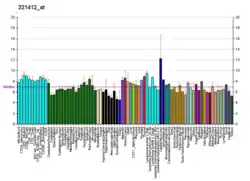VN1R1
Vomeronasal type-1 receptor 1 is a protein that in humans is encoded by the VN1R1 gene.[3][4]
| VN1R1 | |||||||||||||||||||||||||
|---|---|---|---|---|---|---|---|---|---|---|---|---|---|---|---|---|---|---|---|---|---|---|---|---|---|
| Identifiers | |||||||||||||||||||||||||
| Aliases | VN1R1, V1RL1, VNR19I1, ZVNH1, ZVNR1, vomeronasal 1 receptor 1 | ||||||||||||||||||||||||
| External IDs | OMIM: 605234 HomoloGene: 110801 GeneCards: VN1R1 | ||||||||||||||||||||||||
| |||||||||||||||||||||||||
| |||||||||||||||||||||||||
| |||||||||||||||||||||||||
| Orthologs | |||||||||||||||||||||||||
| Species | Human | Mouse | |||||||||||||||||||||||
| Entrez |
| ||||||||||||||||||||||||
| Ensembl |
| ||||||||||||||||||||||||
| UniProt |
| ||||||||||||||||||||||||
| RefSeq (mRNA) |
| ||||||||||||||||||||||||
| RefSeq (protein) |
| ||||||||||||||||||||||||
| Location (UCSC) | Chr 19: 57.45 – 57.46 Mb | n/a | |||||||||||||||||||||||
| PubMed search | [2] | n/a | |||||||||||||||||||||||
| Wikidata | |||||||||||||||||||||||||
| |||||||||||||||||||||||||
Function
Pheromones are chemical signals that elicit specific behavioral responses and physiologic alterations in recipients of the same species. The protein encoded by this gene is similar to pheromone receptors and is primarily localized to the olfactory mucosa. An alternate splice variant of this gene is thought to exist, but its full length nature has not been determined.[4]
Ligands
- Hedione[5]
References
- GRCh38: Ensembl release 89: ENSG00000178201 - Ensembl, May 2017
- "Human PubMed Reference:". National Center for Biotechnology Information, U.S. National Library of Medicine.
- Rodriguez I, Greer CA, Mok MY, Mombaerts P (September 2000). "A putative pheromone receptor gene expressed in human olfactory mucosa". Nature Genetics. 26 (1): 18–9. doi:10.1038/79124. PMID 10973240. S2CID 21063460.
- "Entrez Gene: VN1R1 vomeronasal 1 receptor 1".
- Wallrabenstein I, Gerber J, Rasche S, Croy I, Kurtenbach S, Hummel T, Hatt H (June 2015). "The smelling of Hedione results in sex-differentiated human brain activity". NeuroImage. 113: 365–73. doi:10.1016/j.neuroimage.2015.03.029. PMID 25797832. S2CID 6526522.
Further reading
- Giorgi D, Friedman C, Trask BJ, Rouquier S (December 2000). "Characterization of nonfunctional V1R-like pheromone receptor sequences in human". Genome Research. 10 (12): 1979–85. doi:10.1101/gr.10.12.1979. PMC 313059. PMID 11116092.
- Pantages E, Dulac C (December 2000). "A novel family of candidate pheromone receptors in mammals". Neuron. 28 (3): 835–45. doi:10.1016/S0896-6273(00)00157-4. PMID 11163270. S2CID 15023062.
- Takeda S, Kadowaki S, Haga T, Takaesu H, Mitaku S (June 2002). "Identification of G protein-coupled receptor genes from the human genome sequence". FEBS Letters. 520 (1–3): 97–101. doi:10.1016/S0014-5793(02)02775-8. PMID 12044878. S2CID 7116392.
- Zhang J, Webb DM (July 2003). "Evolutionary deterioration of the vomeronasal pheromone transduction pathway in catarrhine primates". Proceedings of the National Academy of Sciences of the United States of America. 100 (14): 8337–41. Bibcode:2003PNAS..100.8337Z. doi:10.1073/pnas.1331721100. PMC 166230. PMID 12826614.
- Mitropoulos C, Papachatzopoulou A, Menounos PG, Kolonelou C, Pappa M, Bertolis G, Gerou S, Patrinos GP (2007). "Association study of human VN1R1 pheromone receptor gene alleles and gender". Genetic Testing. 11 (2): 128–32. doi:10.1089/gte.2006.0516. PMID 17627382.
This article incorporates text from the United States National Library of Medicine, which is in the public domain.
This article is issued from Wikipedia. The text is licensed under Creative Commons - Attribution - Sharealike. Additional terms may apply for the media files.


